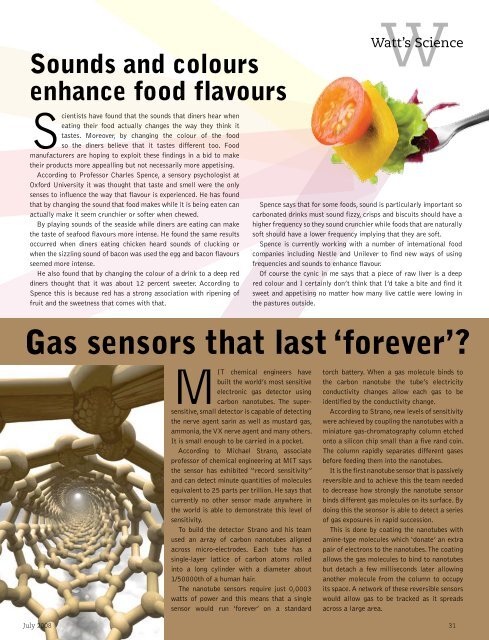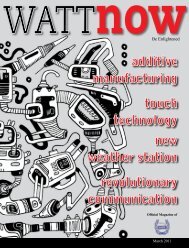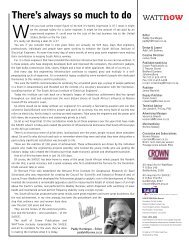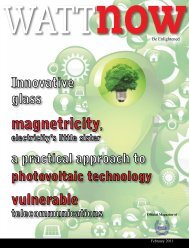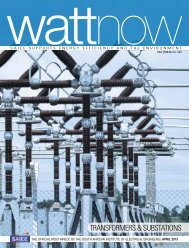Cut electricity consumption with automation - Watt Now Magazine
Cut electricity consumption with automation - Watt Now Magazine
Cut electricity consumption with automation - Watt Now Magazine
Create successful ePaper yourself
Turn your PDF publications into a flip-book with our unique Google optimized e-Paper software.
Sounds and colours<br />
enhance food flavours<br />
Scientists have found that the sounds that diners hear when<br />
eating their food actually changes the way they think it<br />
tastes. Moreover, by changing the colour of the food<br />
so the diners believe that it tastes different too. Food<br />
manufacturers are hoping to exploit these findings in a bid to make<br />
their products more appealling but not necessarily more appetising.<br />
According to Professor Charles Spence, a sensory psychologist at<br />
Oxford University it was thought that taste and smell were the only<br />
senses to influence the way that flavour is experienced. He has found<br />
that by changing the sound that food makes while it is being eaten can<br />
actually make it seem crunchier or softer when chewed.<br />
By playing sounds of the seaside while diners are eating can make<br />
the taste of seafood flavours more intense. He found the same results<br />
occurred when diners eating chicken heard sounds of clucking or<br />
when the sizzling sound of bacon was used the egg and bacon flavours<br />
seemed more intense.<br />
He also found that by changing the colour of a drink to a deep red<br />
diners thought that it was about 12 percent sweeter. According to<br />
Spence this is because red has a strong association <strong>with</strong> ripening of<br />
fruit and the sweetness that comes <strong>with</strong> that.<br />
W<br />
<strong>Watt</strong>’s Science<br />
Spence says that for some foods, sound is particularly important so<br />
carbonated drinks must sound fizzy, crisps and biscuits should have a<br />
higher frequency so they sound crunchier while foods that are naturally<br />
soft should have a lower frequency implying that they are soft.<br />
Spence is currently working <strong>with</strong> a number of international food<br />
companies including Nestle and Unilever to find new ways of using<br />
frequencies and sounds to enhance flavour.<br />
Of course the cynic in me says that a piece of raw liver is a deep<br />
red colour and I certainly don’t think that I’d take a bite and find it<br />
sweet and appetising no matter how many live cattle were lowing in<br />
the pastures outside.<br />
Gas sensors that last ‘forever’<br />
MIT chemical engineers have<br />
built the world’s most sensitive<br />
electronic gas detector using<br />
carbon nanotubes. The supersensitive,<br />
small detector is capable of detecting<br />
the nerve agent sarin as well as mustard gas,<br />
ammonia, the VX nerve agent and many others.<br />
It is small enough to be carried in a pocket.<br />
According to Michael Strano, associate<br />
professor of chemical engineering at MIT says<br />
the sensor has exhibited “record sensitivity”<br />
and can detect minute quantities of molecules<br />
equivalent to 25 parts per trillion. He says that<br />
currently no other sensor made anywhere in<br />
the world is able to demonstrate this level of<br />
sensitivity.<br />
To build the detector Strano and his team<br />
used an array of carbon nanotubes aligned<br />
across micro-electrodes. Each tube has a<br />
single-layer lattice of carbon atoms rolled<br />
into a long cylinder <strong>with</strong> a diameter about<br />
1/50000th of a human hair.<br />
The nanotube sensors require just 0,0003<br />
watts of power and this means that a single<br />
sensor would run ‘forever’ on a standard<br />
torch battery. When a gas molecule binds to<br />
the carbon nanotube the tube’s <strong>electricity</strong><br />
conductivity changes allow each gas to be<br />
identified by the conductivity change.<br />
According to Strano, new levels of sensitivity<br />
were achieved by coupling the nanotubes <strong>with</strong> a<br />
miniature gas-chromatography column etched<br />
onto a silicon chip small than a five rand coin.<br />
The column rapidly separates different gases<br />
before feeding them into the nanotubes.<br />
It is the first nanotube sensor that is passively<br />
reversible and to achieve this the team needed<br />
to decrease how strongly the nanotube sensor<br />
binds different gas molecules on its surface. By<br />
doing this the seonsor is able to detect a series<br />
of gas exposures in rapid succession.<br />
This is done by coating the nanotubes <strong>with</strong><br />
amine-type molecules which ‘donate’ an extra<br />
pair of electrons to the nanotubes. The coating<br />
allows the gas molecules to bind to nanotubes<br />
but detach a few milliseconds later allowing<br />
another molecule from the column to occupy<br />
its space. A network of these reversible sensors<br />
would allow gas to be tracked as it spreads<br />
across a large area.<br />
May June July 2008<br />
31


